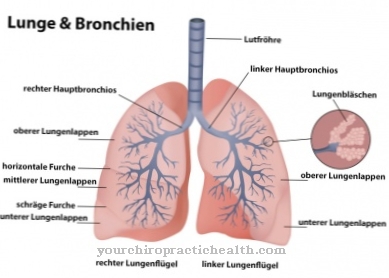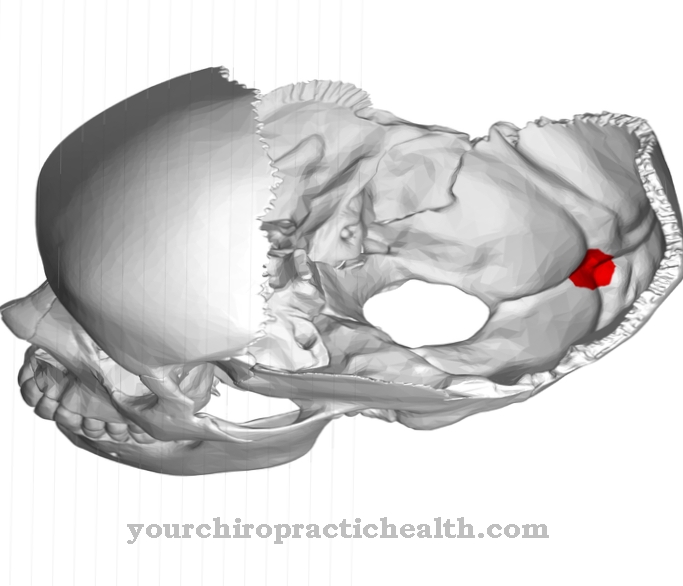Of the Celiac trunk is an unpaired artery trunk that arises towards the front of the abdomen (ventrally) from the abdominal part of the aorta still above the paired renal arteries.
After a few centimeters it branches into three more arteries, which supply various abdominal organs and part of the mesentery with arterial, oxygen-rich blood. Since the celiac trunk arises just below the passage of the aorta through the diaphragm, the arterial trunk can be affected by compression, the Dunbar syndrome.
What is the celiac trunk?
The celiac trunk is a common arterial trunk that arises ventrally (on the abdomen) as an unpaired branch from the abdominal aorta at the level of the twelfth thoracic vertebra below the aortic passage through the diaphragm (hiatus aorticus).
After a few centimeters, the parent artery branches into the three arteries, the splenic artery, the left gastric artery and the common hepatic artery. The area of the branching into three arteries is also known as Haller's tripod or tripus celiacus. The three branching arteries supply the abdominal organs liver, pancreas (pancreas), stomach, spleen, duodenum (duodenum) and the associated mesentery (mesentery) with fresh, oxygenated blood. Any malfunction of the celiac trunk can be immediately life-threatening.
Anatomy & structure
Haller's tripod of the celiac trunk deserves special attention, as the "normal" branching into the three above-mentioned arteries directly in the tripod is only present in an estimated 55 to 62 percent of people. In the remaining cases with a statistically relevant cluster there are more than ten different anomalies.
For example, the anatomist Hellmuth Michels puts the frequency of variants II and III at 10 and 11 percent, respectively. Variant II is the anatomical peculiarity that the common hepatic artery does not arise directly from the tripod, but from the left abdominal artery, the left gastric artery. Variant III occurs when the right gastric artery, the dextra gastric artery, does not originate from the common hepatic artery (common hepatic artery), but rather from the superior mesenteric artery, which is a separate branch from the abdominal aorta.
Other anatomical anomalies with a noteworthy frequency of 7 to 8 percent such as variants VI and VII correspond to normal anatomy, each with an accessory hepatic artery. The wall structure of the celiac trunk corresponds to that of other large arteries. The three wall layers tunica intima, tunica media and tunica externa can be distinguished from inside to outside. The tunica interna or interna consists of a single-layer endothelium followed by loose connective tissue, which is separated from the media by an elastic membrane.
The tunica media or media mainly consists of ring-shaped and oblique smooth muscle cells as well as elastic connective tissue and collagen fibers. A highly elastic membrane separates the media from the tunica externa, which is formed from connective tissue and is traversed by "supply lines" such as blood vessels and nerves.
Function & tasks
The main function of the abdominal cavity trunk, as the celiac trunk is also called, is to forward the oxygen-rich blood to the three arteries which, in normal anatomy, arise from the abdominal cavity trunk. The three arteries supply the connected abdominal cavity organs via further branches and branches.
The walls of the abdominal cavity trunk correspond to the structure of the large elastic arteries close to the heart, so that they are also actively involved in smoothing out the systolic blood pressure peaks and at the same time are involved in maintaining diastolic blood pressure through vasoconstriction during diastole, the resting phase of the two heart chambers. The diastolic “residual blood pressure” is extremely important in order to prevent the narrow arterioles and capillaries from collapsing and their walls sticking together irreversibly.
The smooth muscle cells of the trunk of the abdominal cavity are dependent on signals from the baroreceptors in the two carotid arteries because there are no pressure sensors in the intestinal part of the bloodstream. The celiac trunk takes on part of the so-called Windkessel function of the large arteries close to the heart to smooth the flow of blood on the arterial side of the bloodstream.
You can find your medication here
➔ Medication for heartburn and bloatingDiseases
One of the most important diseases or complaints related to the abdominal cavity stem from a mechanical obstruction of the blood flow. The phenomenon, known as Celiac Truncus Compression Syndrome or Dunbar Syndrome, is mostly due to a slight abnormality in the medial arcuate ligament or a slightly offset origin of the abdominal trunk.
The tissue band, which normally runs above the artery trunk and strengthens the edge of the aortic duct (hiatus aorticus) through the diaphragm, can partially pinch off the abdominal cavity trunk and also the celiac ganglion lying on it, so that an additional nerve compression occurs. Symptoms such as cramping abdominal pain, nausea and indigestion depend on the degree of obstruction to the blood flow. The symptoms therefore range from minor complaints to severe and unbearable pain and life-threatening conditions. In the presence of a chronic compression syndrome, there is also secondary damage to the organs that are normally supplied by the pinched artery or arteries.
In some cases where other arteries, such as the superior pancreaticoduodenal artery, act as a replacement artery, the excessive demands placed on the "replacement artery" can cause aneurysms to form, which can lead to dangerous internal bleeding. In rare cases an isolated dissection requiring treatment has been observed in the area of the celiac trunk. This means that blood seeps in between the inner wall layer, the tunica intima and the tunica media, which can cause considerable discomfort. Most dissections are caused by tears in the intima or injuries.













.jpg)

.jpg)
.jpg)











.jpg)